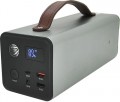Peak power
Some electrical appliances (in particular, units with electric motors - refrigerators, air conditioners, etc.) consume significantly more energy at startup than after reaching the operating mode. For such a load, the peak power of the charging station must be taken into account - its indicator must be higher than the starting power of the load.
Output waveform
Line shape on a graph of the voltage output from a charging station. The quality of power provided by the device depends on this parameter.
—
Sine wave (PSW — Pure Sine Wave). The signal is in the form of a smooth wave without sharp steps, maximally corresponding to the parameters of conventional AC networks. Charging stations with this output signal form can be used for almost any type of load, incl. for powering sensitive electronics that place high demands on the quality of the input voltage.
— Modified sine wave. In a signal similar to a sine wave, the waves on the graph are formed not by smooth lines, but by characteristic “steps” (i.e., jerks). An approximated sine wave is not suitable for powering sensitive electronics, but in general there are not so many such devices in the total number, and circuits with a modified sine wave do not require the creation of expensive and complex technical solutions. As a result, they are cheaper.
UPS function
Charging stations with
UPS function switch consumers to backup power from their own battery, acting as an uninterruptible power supply. In comparison with full-fledged UPSs, switching does not occur instantly, but with a certain delay (about 10-30 ms). To use this function correctly, you must first study the instructions for the charging station, which often describes the correct procedure for connecting the intended consumer devices.
USB A
Full-size USB A connectors are popular in computer technology, they are standardly used in adapter chargers for 230 V household networks and 12 V auto sockets. In charging stations, such outlets are widely used for charging gadgets.
- The total number of such ports can be very diverse (
1 USB,
2 connectors,
3 ports and even
4), since it allows you to connect for charging, and in some cases for power, various low-power devices -
smartphones,
tablets,
power banks,
lamps, etc. .
- The strength of the power. The maximum power output through the USB A connector to the device being charged. Note that different ports of the charging station can output different power (for example, 1.5 A and 2.1 A). In this case, the highest power strength is usually indicated.
— Power. The maximum
output power in watts (W) that the charging station is capable of delivering through the USB A connector to one charging device.
USB A (quick charge)
Full size
USB A ports with fast charging support. It allows you to charge your smartphone, tablet or other connected device much faster. The charging process takes place at increased power, and the current and voltage at each stage are regulated in such a way as to remain within the optimal values. However, it should be borne in mind that in our time there are many fast charging technologies and not all of them are compatible with each other.
- The strength of the current. The parameters of the current issued through the USB A fast charging connectors. Note that different voltage and current parameters can be output to different ports of the charging station. This item specifies the current values at a certain voltage (for example, 5 V / 3 A, 9 V / 2 A, 12 V / 1.5 A).
— Power. The maximum power in watts (W) that the charging station is capable of delivering through the USB A fast charging connector to one charging device. High output power allows you to speed up the charging process. However, the appropriate power must be supported by the device being charged - otherwise the speed of the process will be limited by the characteristics of the gadget.
USB C
USB type C ports are smaller than classic USBs, and they also have a convenient reversible design that allows you to connect the plug in either direction.
USB type C was originally designed to be able to implement various advanced features: increased power supply, fast charging technologies, etc.
Since the port is relatively new and quite powerful (there are
USB type C with a power of 60 W and even
100 W), the total number of such connectors is often limited to
1 port, less often
two).
- The strength of the power. The maximum power output through the USB type C connector to a charging device. Note that different ports of the charging station can output different power (for example, 1.5 A and 2.1 A). In this case, the highest power strength is usually indicated.
— Power. The maximum power in watts (W) that the charging station is capable of delivering to one rechargeable gadget. The high output power of the USB type C port allows you to speed up the charging process. However, the appropriate power must be supported by the device being charged - otherwise the speed of the process will be limited by the characteristics of the gadget.
From solar panels
The ability to charge the device from solar panels ensures the energy independence of a portable power plant. Models with this function can work completely autonomously and do not depend on outlets.
Charging from the panels is implemented in the corresponding devices with portable solar panels and charging stations, which are structurally provided with specialized connectors for receiving power from stationary solar panels, and there is also a built-in MPPT charge controller (Maximum Power Point Tracking).
Battery capacity
Nominal
battery capacity, in fact - the amount of energy that is supposed to be stored. The larger it is, the longer the battery life of the charging station will be, all other things being equal. On the other hand, this parameter also affects the dimensions, weight and price of the battery, despite the fact that an energy-intensive battery is not always required. By the indicator of capacity in watt-hours, you can compare batteries with each other.
Charging cycles
The number of charge-discharge cycles that the battery can withstand without significant loss of performance.
In the process of operation, the batteries wear out, which causes their performance to suffer (in the first place, the capacity decreases). Battery life is usually measured in charge-discharge cycles. However, models with the same declared resource are not always equally durable in practice. Different manufacturers may interpret “significant loss of performance” in different ways: for example, one brand indicates the resource up to a 20% decrease in capacity (DOD > 80%), another - up to a 60% decrease (DOD > 40%) Behind the abbreviation DOD worth decoding Depth of Discharge, i.e. discharge depth. Therefore, when choosing, it makes sense to focus not only on pure numbers, but also on other sources - test results, reviews, etc. Also note that battery life can be noticeably reduced if the operating conditions are violated (for example, in case of overheating or hypothermia).

